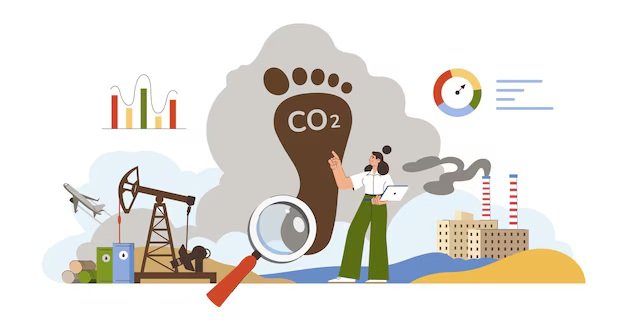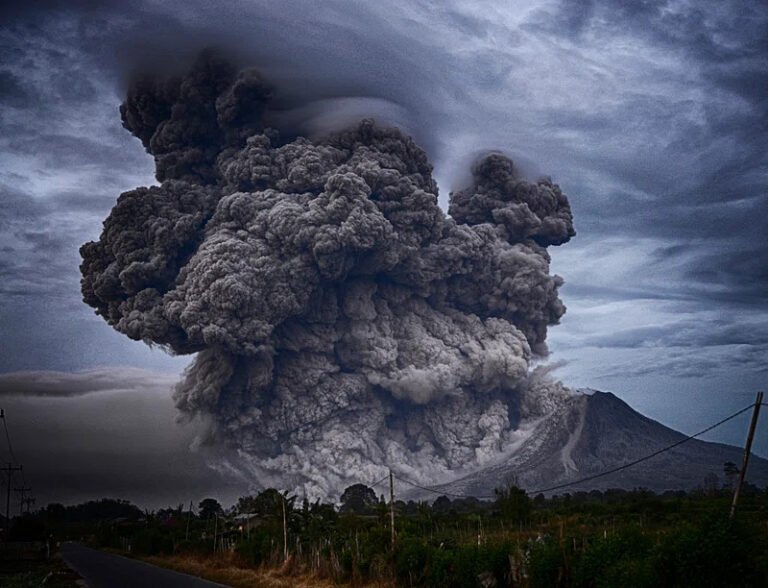CO₂ Breaks Records — What the Numbers Actually Mean
Global carbon dioxide jumped by an unprecedented amount in 2024, pushing atmospheric concentrations to levels that will warm the planet for centuries and make extreme heat and other shocks more likely. According to the World Meteorological Organization, the global average CO₂ concentration in 2024 reached about 423.9 parts per million (ppm) — and the year-to-year rise from 2023 to 2024 was roughly 3.5 ppm, the largest single annual increase since modern monitoring began.
A spokesperson for WMO summed the science in plain terms when she warned that “the heat trapped by CO₂ and other greenhouse gases is turbo-charging our climate,” highlighting both the size of the rise and the drivers behind it: continued fossil-fuel emissions, intense wildfires, and weaker carbon “sinks” such as drought-stressed forests and warmer oceans that absorb less CO₂. A report by WMO in 2025 found these changes are already feeding back on the climate system and increasing the risk of more frequent and intense extremes.
Independent long-running monitoring confirms the picture. NOAA’s Global Monitoring Laboratory data show a multi-year upward trend in CO₂, with monthly global means projected to move into the mid-420s ppm by 2024–2025 — well above pre-industrial levels and far outside the range humans have experienced for hundreds of thousands of years. According to NOAA, these higher concentrations lock in additional warming, even if emissions were to stabilise tomorrow, because CO₂ remains in the atmosphere for centuries.
| Year | Global average CO₂ (approx.) | Note |
|---|---|---|
| 2000 | ~370 ppm | Start of 21st-century reference era. (NOAA/WMO data) |
| 2010 | ~389 ppm | Continued steady rise. (NOAA) |
| 2020 | ~414 ppm | Pandemic year but long-term rise continues. (NOAA) |
| 2024 | 423.9 ppm | WMO: record single-year jump of ~3.5 ppm. (WMO) |
(Values rounded for clarity; sources: WMO and NOAA.)

In This Article
- What Cities Will Actually Feel Next
- Impact — Short Case Studies
- What Cities, Businesses, and Consumers Can Do Next
- Conclusion
What Cities Will Actually Feel Next
Cities concentrate people, infrastructure and heat — which makes them uniquely vulnerable as the planet warms. The combination of rising baseline temperatures, more heatwave events, worsening air quality (from local pollution plus wildfire smoke), and stressed infrastructure will change daily life in ways people already notice. A large body of evidence summarised by the IPCC and recent peer-reviewed studies shows that every additional increment of global warming amplifies urban heat extremes, raises the frequency and duration of dangerous hot days, and worsens the urban heat-island effect that causes cities to stay hotter at night. A chapter on cities in the IPCC’s assessment emphasises that urban populations will face increased heat-related illness and infrastructure strain unless adaptation is scaled up quickly.
Practically speaking, residents of many cities should expect four immediate, overlapping changes: longer and more dangerous heatwaves (more hospital visits, power strain and heat-related deaths); more frequent episodes of poor air quality as ozone forms faster in hotter air and wildfire smoke travels long distances; higher energy demand during heat spikes which can cause rolling outages or strained grids; and increasing wear on transport and water systems — from buckled rails to burst pipes and overwhelmed drainage. Research published in Nature and Lancet-family journals shows that urban heat islands can raise mortality risk during extreme heat by tens of per cent compared with nearby rural areas, and that cities with older populations, limited access to cooling, or large informal settlements will suffer most.
Impact — Short Case Studies
New York City has already seen the collision of distant wildfires, heat, and social vulnerability. During major heat episodes in recent years, city data and reporting show elevated emergency calls and deaths among people without reliable access to air conditioning; one resident described cramped apartments as “literally unbearable” during extreme heat, illustrating how indoor living conditions amplify risk for families and people with respiratory conditions. A Reuters analysis of U.S. city heat found tens of millions under heat warnings during severe events, and local health reports estimate several hundred premature heat-related deaths in New York annually, concentrated among socially vulnerable neighbourhoods. These are not hypothetical numbers — they are patterns visible in hospital admissions and mortality statistics.
In West Africa — including Lagos and neighbouring coastal urban areas — people reported “blistering” heat that upended work and sleep during the 2024 season. Journalists from The Guardian documenting the 2024 West Africa heatwave quoted residents who changed work hours, skipped school, or struggled to find drinking water. Scientists attributed a strong human fingerprint to the event: in some locations, the heat was several degrees warmer and many times more likely because of human-caused warming. That lived experience — interrupted sleep, lost wages, and health strain — could become the day-to-day reality for millions of urban residents if global greenhouse gas trends continue.
Across Asia, large cities such as Chongqing have issued their highest heat warnings in recent summers. Reporting by Reuters in 2025 described elderly residents seeking shade in subway entrances, while the power grid faced record electricity demand as cooling needs surged. These on-the-ground reactions align with model-based forecasts: hotter summers mean higher peak loads on electricity systems and more frequent emergency cooling centres or temporary closures of vulnerable outdoor work.
Health science ties these stories to population impacts: the World Health Organization and the State of Global Air reports document millions of premature deaths annually tied to air pollution and heat-aggravated illnesses, and researchers warn that worsening air quality combined with heat will multiply the public-health burden in cities unless mitigation and targeted adaptation are rapidly expanded. A Health Effects Institute report found that in 2021, air pollution contributed to roughly 8.1 million deaths worldwide, underscoring how climate-driven increases in smoke and ozone will interact with long-standing urban pollution problems.
What Cities, Businesses, and Consumers Can Do Next
The good news is twofold: the long-term warming path depends on emissions choices today, and cities can take practical, cost-effective steps now to reduce near-term harm. First, the global picture. The WMO warns that the recent CO₂ surge is partly driven by wildfires and weaker sinks — meaning both reducing emissions and protecting natural carbon stores (forests, peatlands, mangroves) matter enormously. The agency’s 2025 report called for strengthened monitoring and faster policy action to close the gap between national climate pledges and what science says is needed to avoid the worst scenarios.
For city managers and utilities, immediate priorities include: expanding and mapping cooling centers and safe places; prioritizing low-income and informal neighborhoods for heat-safety outreach and direct cooling support; hardening power grids and diversifying electricity supplies to prevent blackouts during peak demand; increasing urban tree cover and reflective surfaces to reduce street temperatures; and integrating early-warning systems that combine heat forecasts with air-quality alerts and social outreach. Many interventions — tree planting, cool roofs, and targeted support for at-risk people — are proven to reduce heat exposure and health harms while delivering co-benefits (reduced energy bills, improved air quality). The IPCC and many city case studies recommend these scalable measures
For businesses and consumers: firms should stress-test critical operations for heat and smoke risk (supply chains, worker protection, equipment cooling) and invest in resilient cooling strategies that avoid runaway emissions (e.g., efficient air conditioning, shaded work areas, heat-adapted schedules). Consumers can reduce household contributions to overheating (insulation, shading, efficient appliances), support healthier energy choices, and participate in local cooling or tree-planting programs. At the same time, policy levers — stronger clean-air standards, incentives for heat-resilient housing, and fossil-fuel phaseouts — are essential to bend the global trajectory. Governments, businesses and civil society must act together: the recent WMO bulletin makes clear that monitoring, mitigation and adaptation need to be scaled up now to prevent worse lock-in.
Practical checklist for immediate steps (examples from cities and research):
- Make cooling centres visible, free and accessible, and target outreach to the elderly, outdoor workers and low-income households. (City heat action plans and case studies.)
- Invest in urban greening and reflective materials — studies link these measures to measurable drops in peak surface temperatures and lower heat-related deaths.
Conclusion
The record rise in atmospheric CO₂ documented by WMO in 2025 is not a distant statistic — it is a real driver of hotter, longer, and more dangerous summers that cities are already feeling in the form of heatwaves, wildfire smoke intrusions, and strained infrastructure. The science and recent reporting show the health, social and economic costs are concentrated in cities and among vulnerable populations, but a mix of fast, targeted local actions and much stronger global emissions cuts can reduce near-term harms and buy time for deeper transformation. According to the WMO (2025) and corroborated by long-term monitoring from NOAA (2025), the path is still alterable — but only if policy and everyday choices move from incremental to urgent.







